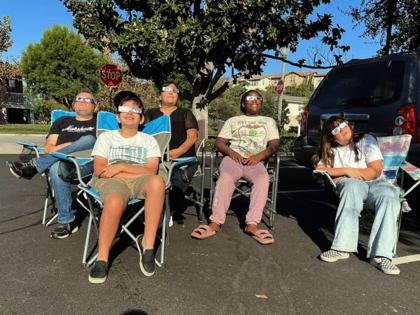Solar eclipse thrills crowds in California as it darkens swath of countryside
Published in Science & Technology News
LOS ANGELES — Nancy Castellanos and her 5-year-old daughter, Camilla, sat on a striped picnic blanket outside the California Science Center with their eyes fixed to the sky.
Castellanos, 39, reminded her daughter not to look up without protective eclipse glasses. It was Camilla’s first time experiencing the phenomenon of a solar eclipse. They waited and watched as the moon began streaking across the sun, taking a chunk out of the bright mass. In Los Angeles, at the eclipse’s peak, about 50% of the sun will be blocked.
“It’s such a memorable event, especially for the children,” Castellanos said as Camilla cuddled in her lap. “She can remember this later on and watch the next one too.”
Millions of people across the United States collectively looked up at the sky Monday to witness a rare total solar eclipse. And although California didn’t experience the phenomenon of totality, there was still plenty to see.
A total solar eclipse happens when the moon passes between the sun and the Earth, completely blocking the face of the sun and casting a shadow across a wide strip of the planet below. For people in that strip, known as the path of totality, the sky will become dark as night and the temperature might drop.
Outside the path of totality, people on the daylight side of the globe will experience a partial eclipse in which the moon covers a portion of the sun. In Los Angeles, this will be visible starting at 10:06 a.m.
A substantial blocking of the sun will be obvious by 10:39 a.m. and will peak at 11:12 a.m. By 12:22 p.m., it will be over, according to the Griffith Observatory.
“It’s an opportunity to see firsthand our place in the universe,” said Paul Robertson, an associate professor of physics and astronomy at UC Irvine. “We’re sitting on the surface of this rock that’s careening through space at a speed of 30 kilometers per second, and we’re doing this sort of gravitational dance with these other giant bodies.”
During a partial solar eclipse, we can see the Earth, sun and moon “at the same time interacting in a way that they usually don’t,” Robertson said.
Unlike elsewhere in the country, where cloudy skies risk spoiling the view for eclipse chasers, forecasters are predicting a sunny, clear day in Southern California. Downtown Los Angeles is expected to see temperatures in the mid-70s. The mercury could temporarily drop a few degrees during the actual eclipse because of the reduction in solar radiation, said Kristan Lund, a meteorologist with the National Weather Service.
Roughly a thousand people gathered on the athletic field outside the Cahill Center for Astronomy and Astrophysics at Caltech in Pasadena ahead of the eclipse. The crowd to enter the campus and grab protective eyewear was so large that it snaked at least a block along East California Boulevard.
Some families brought chairs and laid out blankets to relax and munch on snacks while they waited for the eclipse.
Ryan Rudes, a freshman at Caltech, skipped his math class to take photos of the eclipse. He created a makeshift eclipse filter for his Canon T6 camera using duct tape and lenses from his orange eclipse glasses. He had hoped to view the eclipse from Niagara Falls this year, but cloudy skies in the forecast for that part of the Northeast dashed his plans.
Don Payne, who lives near Caltech, was shocked by the size of the crowd at the school while he strolled along the campus with Bella, his 7-year-old Lakeland Terrier.
“There’s never any crowd [at Caltech] like this,” he said.
The buzz around this celestial event has been palpable, for both the scientific possibilities and the rarity.
The last total solar eclipse that crossed the contiguous United States was in August 2017, according to NASA. Another one won’t cross again for 20 years.
The eclipse will begin over the South Pacific Ocean and will move diagonally across Mexico, the United States and Canada. Mexico’s Pacific coast will be the first location in continental North America to experience totality, which will happen there around 11:07 a.m.
The eclipse will enter the United States in Texas and make its way through Oklahoma, Arkansas, Missouri, Illinois, Kentucky, Indiana, Ohio, Pennsylvania, New York, Vermont, New Hampshire and Maine. A map on NASA’s website provides an approximate time that each location in the path of totality will see the eclipse.
More than 30 million Americans who live in the path of totality will get a chance to experience a total solar eclipse, and many others are preparing to travel to see the phenomenon. Cities in the path are expecting an influx of visitors and major traffic jams as people flood to those communities to get a glimpse of the scientific wonder.
Colleges and science centers across California, including UC Irvine, Cal State Los Angeles and the California Science Center are hosting eclipse viewing parties.
The California Science Center provided paper and plastic protective glasses and materials to make pinhole cameras to view the eclipse safely. Tables with educational brochures and eclipse paraphernalia lined the sidewalks.
As the solar eclipse reached its peak, Dani Ortuño Gudiño, a photographer working on his master’s degree in media studies, lay on his back on the ground outside the Science Center. He held a pair of paper eclipse glasses up to the lens of his camera, a Sony Alpha 73. The result was a crisp, stunning photo of the moon overlapping with the sun. The visible part of the sun was in a crescent shape overhead.
Nearby Dalton Cantor, 16, held his glasses against his face as he gazed up at the sky.
“My family and I decided to come here to experience something unique,” he said. “It’s powerful. It pauses everything you’re going through.”
Cantor lives near the Science Center and used to visit nearly every weekend when he was younger. He was excited to be there Monday with his mother and grandmother.
“It’s a rare opportunity,” said his grandmother, Ana Rodriguez. “We couldn’t miss it.”
Adequate eye protection is a must to view the eclipse directly.
People should obtain eclipse glasses or handheld sun filters, but take caution to buy them from reputable retailers and inspect them for any damage prior to viewing the eclipse. The glasses should comply with the ISO 12312-2 international standard, according to NASA.
People without protection can still view the eclipse indirectly through a homemade pinhole projector. And even if you do have eye protection, experts say, you shouldn’t gaze at the sun for more than a few moments at a time.
Bhavini Lad, an aerospace engineer, was excited to bring her 7-year-old twins and 5-year-old son to Caltech to see their first eclipse. The kids’ bedroom is space-themed, with a replica solar system hanging from the ceiling.
“They love to learn about it because they have the stuff in their room,” Lad said, adding that they’ve talked about how to view the phenomenon safely.
“You don’t look without the glasses because what will happen?” Lad asked her son.
He shouted his response: “You’ll get blind!”
Past eclipses have enabled scientists to study the sun’s structure, provide the first proof of Einstein’s theory of general relativity and even discover helium decades before the element was found on Earth.
Robertson can’t quite put his finger on what stirs such emotions among people who have witnessed a total solar eclipse. During the 2017 eclipse, he said, people in his viewing group were brought to tears by the sight.
“You can see the pictures and the pictures are really spectacular,” he said. “But there’s just no substitute for seeing it in person.”
Times s taff writer Rong-Gong Lin II contributed to this report.
©2024 Los Angeles Times. Visit at latimes.com. Distributed by Tribune Content Agency, LLC.







Comments